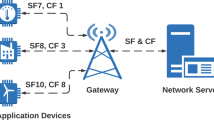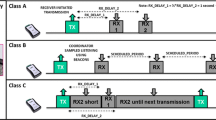Abstract
With the ever growing internet of things market, Low Power Wide Area Networks (LPWAN) become more and more attractive. Among the various LPWAN technologies, LoRa (and LoRaWAN) has drawn a lot of research attention with its great adaptation capability. In fact, its spectrum modulation spreading factor, transmission power, data rate, channel bandwidth, and coding rate are so many configurable parameters allowing to cope with a large number of use cases. In addition, through its ADR (Adaptive Data Rate) function, LoRa offers an interesting mechanism to self-adapt its configuration to its operational conditions. Several works have been carried out for extending ADR to further improve its performance for different use cases. LoRa has even been recently investigated on its capacity to support the mobility, although it is not originally designed for. In this paper, we first review the most significant ADR enhancements proposed in the literature, then describe our earlier E-ADR proposal [1] aiming at dealing with the node mobility use case. This paper also provides experimental performance evaluations of the reviewed ADR enhancements in a mobile node scenario, highlighting the unique feature of E-ADR.




















Similar content being viewed by others
References
Benkahla, N., Tounsi, H.,Song, YQ., & Frikha, M. (2019). Enhanced ADR for LoRaWAN networks with mobility. In 15th IWCMC. Morroco. Accessed 16 Feb 2020.
Semtech. (2015) LoRa. http://www.semtech.com/.
SORNIN (Semtech), N., & YEGIN (Actility), A. (2017). LoRaWAN Specification v1.1.
Bor, M., & Roedig, U. (2017). LoRa transmission parameter selection. In 13th DCOSS. Canada.
Abdelfadeel, K. Q., Cionca, V., & Pesch, D. (2018). A fair adaptive data rate algorithm for loRaWAN. In 18th EWSN. Spain.
Kim, D. Y., Kim, S., Hassan, H., & YukPark, J. H. (2017). Adaptive data rate control in low power wide area networks for long range IoT services. Journal of Computational Science, 22, 171–178.
Slabicki,M., Premsankar, G., & Di Francesco, M. (2018). Adaptive configuration of loRa networks for dense IoT deployments. In NOMS IEEE/IFIP. Taiwan.
Cuomo, F., Campo, Ma., Caponi, A., Bianchi, G., Rossini, G., Pisani, P. (2017). EXPLoRa: Extending the performance of LoRa by suitable spreading factor allocations. In 13th IEEE WiMob. Italy.
Alvear, O., H-Tapia, J., Calafate, C., H-Orallo, E., Cano, J-C, & Manzoni, P. (2017). Assessing the Impact of Mobility on LoRa Communications. In InterIoT/SaSeIoT’17. Spain.
S-Cabrera, R., Pachon, A., & Madrid, J-M. (2019). Proof of concept of an IoT-based public vehicle tracking system, using LoRa (long range) and intelligent transportation system (ITS) services. In Journal of Computer Networks and Communications. Vol 19.
Kousias, K., Caso, G., Alay, O., & Lemic, F. (2019). Empirical Analysis of LoRaWAN Adaptive Data Rate for Mobile Internet of Things Applications. In Wireless of the Students, by the Students, and for the Students Workshop. Mexico.
Libelium comunicaciones Distribuidas S.L. (2015). Waspmote LoRa 868 MHz 915 MHz SX1272 networking guide. V4(2).
Semtech Corporation, STMicroelectronics. (2019). Discovery kit for LoRaWAN, Sigfox, and LPWAN protocols with STM32L0 B-L072Z-LRWAN1.
Libelium Comunicaciones Distribuidas S.L. (2017). Waspmote data frame programming guide.
LoRa Alliance Technical committee LoRaWAN regional parameters. (2018) 1(1).
Hope RF Microelectronics. (2016). RFM95/96/97/98(W)-Low Power Long Range Transceiver Module. China.
Bor, M., Vidler, J., & Roedig, U. (2016). LoRa for the Internet of Things. In 16th EWSN. Austria.
Goursaud, C., & Gorce, J.-M. (2015). Dedicated networks for IoT: PHY/MAC state of the art and challenges. EAI Endorsed Transactions on Internet Things, 1, 1–11.
Croce, D., Gucciardo, M, Tinnirello, I., Garlisi, D., & Mangione, S. (2017). Impact of spreading factor imperfect orthogonality in LoRa communications. In In International Tyrrhenian Workshop on Digital Communication. 165-179, Switzerland.
Semtech LoRa. (2016). http://www.semtech.com/images/datasheet/sx1276777879.pdf. Accessed 5 Jan 2020.
The Thing Network Wiki. (2017). Adaptive Data Rate.
https://www.actility.com/precision-agriculture/. Accessed 29 Jul 2020
Brown, M. (2018). Smart Farming -Automated and Connected Agriculture. In: Designer Edge Article, engineering. com
YANMAR Technical Review. (2019). Self-Driving Robot Tractor: Yanmar Technology for Sustainable Agriculture. Retrieved from https://www.yanmar.com/global/about/technology/technical-review/2019/0403-1.html. Accessed 29 Jul 2020.
Toro, FG., Tsourdos, A. MDPI. (2018). UAV Sensors for Environmental Monitoring.
Goldoni, E., Prando, L., Vizziello, A., Savazzi, P., Gamba, P. (2019). Experimental data set analysis of RSSI-based indoor and outdoor localization in LoRa networks. In Internet Technology Letter.
Saunders, C., Gammerman, A., & Vovk, V. (1998). Ridge Regression Learning Algorithm in Dual Variables. In the 15th ICML proceeding. Madison–Wisconsin.
T. Bouguera, J-F. Diouris, J-J. Chaillout, R. Jaouadi, G. Andrieux. (2018). Energy Consumption Model for Sensor Nodes Based on LoRa and LoRaWAN. MDPI Sensors.
Semtech corporation SX1272/3/6/7/8. (July 2017). LoRa modem an1200.13. Revision 1. P.7.
SX1272/73: 860 MHz to 1020 MHz Low Power Long Range Transceiver. (2019). http://www.semtech.com/images/datasheet/sx1272.pdf. Accessed 30 Jul 2020.
Benkahla, N., Tounsi, H., Song, YQ., & Frikha, M. (2018). Enhanced dynamic duty cycle in LoRaWAN network. In ADHOC-NOW Springer (pp. 47–162). France.
Acknowledgements
This work has been partially supported by Algeria PhD grant, LORIA visiting researcher grant and SupCom PhD grant.
Author information
Authors and Affiliations
Corresponding authors
Ethics declarations
Conflict of interest
The authors declare there is no conflits of interest and competing interests.
Additional information
Publisher's Note
Springer Nature remains neutral with regard to jurisdictional claims in published maps and institutional affiliations.
Rights and permissions
About this article
Cite this article
Benkahla, N., Tounsi, H., Song, YQ. et al. Review and experimental evaluation of ADR enhancements for LoRaWAN networks. Telecommun Syst 77, 1–22 (2021). https://doi.org/10.1007/s11235-020-00738-x
Accepted:
Published:
Issue Date:
DOI: https://doi.org/10.1007/s11235-020-00738-x




